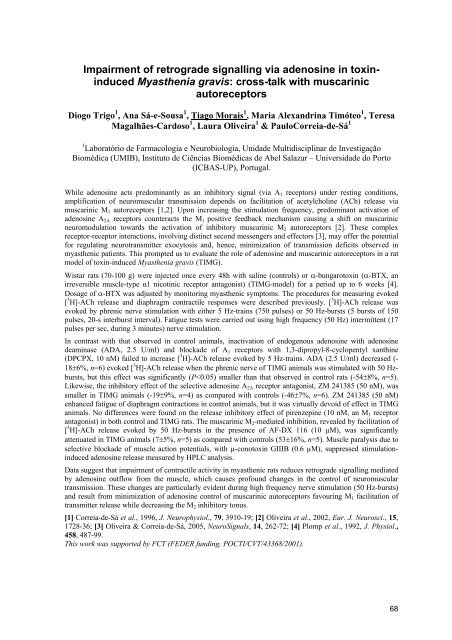IJUP08 - Universidade do Porto
IJUP08 - Universidade do Porto
IJUP08 - Universidade do Porto
- TAGS
- universidade
- porto
- ijup.up.pt
Create successful ePaper yourself
Turn your PDF publications into a flip-book with our unique Google optimized e-Paper software.
Impairment of retrograde signalling via adenosine in toxininduced<br />
Myasthenia gravis: cross-talk with muscarinic<br />
autoreceptors<br />
Diogo Trigo 1 , Ana Sá-e-Sousa 1 , Tiago Morais 1 , Maria Alexandrina Timóteo 1 , Teresa<br />
Magalhães-Car<strong>do</strong>so 1 , Laura Oliveira 1 & PauloCorreia-de-Sá 1<br />
1 Laboratório de Farmacologia e Neurobiologia, Unidade Multidisciplinar de Investigação<br />
Biomédica (UMIB), Instituto de Ciências Biomédicas de Abel Salazar – <strong>Universidade</strong> <strong>do</strong> <strong>Porto</strong><br />
(ICBAS-UP), Portugal.<br />
While adenosine acts pre<strong>do</strong>minantly as an inhibitory signal (via A1 receptors) under resting conditions,<br />
amplification of neuromuscular transmission depends on facilitation of acetylcholine (ACh) release via<br />
muscarinic M1 autoreceptors [1,2]. Upon increasing the stimulation frequency, pre<strong>do</strong>minant activation of<br />
adenosine A2A receptors counteracts the M1 positive feedback mechanism causing a shift on muscarinic<br />
neuromodulation towards the activation of inhibitory muscarinic M2 autoreceptors [2]. These complex<br />
receptor-receptor interactions, involving distinct second messengers and effectors [3], may offer the potential<br />
for regulating neurotransmitter exocytosis and, hence, minimization of transmission deficits observed in<br />
myasthenic patients. This prompted us to evaluate the role of adenosine and muscarinic autoreceptors in a rat<br />
model of toxin-induced Myasthenia gravis (TIMG).<br />
Wistar rats (70-100 g) were injected once every 48h with saline (controls) or α-bungarotoxin (α-BTX, an<br />
irreversible muscle-type α1 nicotinic receptor antagonist) (TIMG-model) for a period up to 6 weeks [4].<br />
Dosage of α-BTX was adjusted by monitoring myasthenic symptoms. The procedures for measuring evoked<br />
[ 3 H]-ACh release and diaphragm contractile responses were described previously. [ 3 H]-ACh release was<br />
evoked by phrenic nerve stimulation with either 5 Hz-trains (750 pulses) or 50 Hz-bursts (5 bursts of 150<br />
pulses, 20-s interburst interval). Fatigue tests were carried out using high frequency (50 Hz) intermittent (17<br />
pulses per sec, during 3 minutes) nerve stimulation.<br />
In contrast with that observed in control animals, inactivation of en<strong>do</strong>genous adenosine with adenosine<br />
deaminase (ADA, 2.5 U/ml) and blockade of A1 receptors with 1,3-dipropyl-8-cyclopentyl xanthine<br />
(DPCPX, 10 nM) failed to increase [ 3 H]-ACh release evoked by 5 Hz-trains. ADA (2.5 U/ml) decreased (-<br />
18±6%, n=6) evoked [ 3 H]-ACh release when the phrenic nerve of TIMG animals was stimulated with 50 Hzbursts,<br />
but this effect was significantly (P










